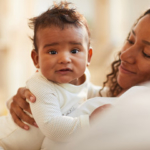While some women with bipolar disorder elect to discontinue their psychotropic medications during pregnancy to mitigate fetal exposure, Viguera and colleagues (2000, 2007) found that women stabilized on lithium face a significant risk for relapse if they choose to discontinue treatment during pregnancy. These treatment decisions are difficult and vary on a case-to-case basis, but currently few studies have compared the developmental trajectory for infants of bipolar mothers who either discontinue or maintain their medications.
In a recent study, Santucci and colleagues (2017) recruited 197 mother-infant dyads over the course of five years, which included 116 control infants born to mothers without bipolar disorder, 27 infants with exposure to maternal bipolar disorder but no psychotropic drug exposure (BD-), and 54 infants with exposure to maternal bipolar disorder and psychotropic drug exposure (BD+).
The Structured Interview Guide for the Hamilton Depression Rating Scale with Atypical Depression Supplement (SIGH-ADS) and a Mania Rating Scale (MRS) were used to assess severity of symptoms in the mothers at 20, 30, and 36 weeks gestation, as well as 12, 26, and 52 weeks postpartum. Infants were assessed with the Bayley Scale of Infant Development, Second Edition (BSID-II) at 12, 26, and 52 weeks of age. The BSID-II includes the Mental Development Index (MDI), the Psychomotor Development Index (PDI), and the Behavioral Rating Scale (BRS). Of note, the BRS evaluates Attention/Arousal/Orientation/Engagement, Emotional Regulation, and Motor Quality during an infant’s assessment periods.
Researchers hypothesized that, overall, infants with exposure to bipolar disorder would score lower than unexposed controls in motor, cognitive, and behavioral development. However, the findings suggest that this was not the case; exposure to maternal bipolar disorder was not a predictor of deficits in these domains.
Infants in the BD- or BD+ did not differ with regard to overall scores on the PDI (psychomotor development), MDI (mental development), or BRS (behavioral rating). However, when comparing the BD+ and BD- groups, the BD+ infants at one year of age were less likely than BD- infants to score above the 75th percentile (11.5% vs. 40%) on the Motor Quality Index (a subset of the Bayley Scale). (This scale measures hypo/hypertonicity, control of movement, frenetic movement, tremulousness, and slower and delayed movements.) The authors note that these minor deficits observed on this subset of the BSID-II are not specific and do not indicate how these symptoms may impact an infant’s daily functioning.
Although the infants with prenatal exposure to medication demonstrated slightly poorer motor quality, it is reassuring that they still were within normal ranges of motor development and that there were no significant differences in other developmental domains.
There are some limitations in this study to consider, including the fact that the researchers were not able to determine the specific psychotropic agents that may be predictors of these minor motor deficits observed in BD+ infants, due to the small sample size and the diversity of medications women used to treat their mood disorder. The dyads were also not analyzed based on the varying mood diagnoses: bipolar I, bipolar II, and bipolar NOS.
This past year, our group at the Center for Women’s Mental Health collaborated with Dr. Charles Nelson at Boston Children’s Hospital after being awarded a NARSAD grant to study the long term neurobehavioral outcomes for children ages 6 to 17 born to bipolar mothers who were followed during their pregnancies in a previous study. We are currently in the data analysis phase for this study, with the hope of being able to elaborate on the minimal research that explores child outcomes after prenatal psychotropic drug exposure.
Olivia Noe, B.S.
Santucci, A. K., Singer, L. T., Wisniewski, S. R., Luther, J. F., Eng, H. F., Sit, D. K., & Wisner, K. L. (2017). One-Year Developmental Outcomes for Infants of Mothers With Bipolar Disorder. The Journal of clinical psychiatry.
Viguera, A. C., Nonacs, R., Cohen, L. S., Tondo, L., Murray, A., & Baldessarini, R. J. (2000). Risk of recurrence of bipolar disorder in pregnant and nonpregnant women after discontinuing lithium maintenance. American Journal of Psychiatry, 157(2), 179-184.
Viguera, A. C., Whitfield, T., Baldessarini, R. J., Newport, D. J., Stowe, Z., Reminick, A., & Cohen, L. S. (2007). Risk of recurrence in women with bipolar disorder during pregnancy: prospective study of mood stabilizer discontinuation. American Journal of Psychiatry, 164(12), 1817-1824.







I’m so glad to read this study, Dr. Noe.
My new book, “Birth of a New Brain – Healing from Postpartum Bipolar Disorder” (Post Hill Press) is endorsed by
Dr. Nancy Byatt. Dr. Kay Redfield Jamison, Dr. Verinder Sharma, Dr. Samantha Meltzer-Brody et al. and I’m honored it’s receiving wonderful reviews.
I’m being told my book, which I began writing after my bipolar, peripartum diagnosis in 2007 and took ten years to write, is helping moms with bipolar, peripartum onset and those who care about them. Studies such as this one will help me become better informed as I embark on presenting a series of educational presentations & webinars (Intl Bipolar Foundation, 2020 Mom Project, Intl Society for Bipolar Disorders) about my experience with bipolar, peripartum onset. Thank you!
Dyane Harwood
p.s. Please forgive my error for assuming you’re an M.D., Ms. Noe!
I just noticed the B.S. after your name.
It’s time for my 1st cup of coffee!! 🙂
Take care,
Dyane
Thank you for sharing this information about women with bipolar disorder. I think it’s a very necessary topic and as many people as possible should know about it. The mother with bipolar disorder, remains at risk of drug exposure or transmission of the disease to her newborn baby. Modern medicine has made great strides forward in investigating these situations. I hope that every year the risks will decrease and medicine will be able to prevent them.